-
EngineTurbo 2.0L I4
-
Power241 HP / 258 LB-FT
-
Transmission8-Speed Automatic
-
0-60 Time7.0 Seconds
-
Top Speed143 MPH
-
DrivetrainRear-Wheel Drive
-
Engine PlacementFront
-
Curb Weight3,805 LBS
-
Seating2+3
-
Cargo16.2 CU-FT
-
MPG20 City / 30 HWY
-
Base Price$46,555
-
As Tested Price$58,565
Last year, Lexus rolled out an ad for its GS that featured several luxury rivals swinging on pendulums, with a hypnotic voiceover that derides the BMW 5 Series' standard four-cylinder engine. The ad then asks viewers to, "Open your eyes to the six-cylinder, eight-speed Lexus GS."
Oh, how times have changed.
Consider the facelifted Lexus GS 200t and its four-cylinder turbocharged engine an admission that maybe the Germans are on to something. It's good to see Lexus getting with the times, but after a drive in Southern California, we find the first turbocharged GS comes up short in a lot of ways.
This is the same engine Lexus uses in the NX, IS, and RC with 200t designations. The 2.0-liter four-cylinder uses a twin-scroll turbo, direct injection, and Toyota's most advanced continuously variable valve timing to produce 241 horsepower and 258 pound-feet of torque. That's 70 horsepower short of the GS 350's 3.5-liter V6. But torque is down only 22 fewer lb-ft, and the 200t's broad peak torque, from 1,650 to 4,400 rpm, promises ample usable power.
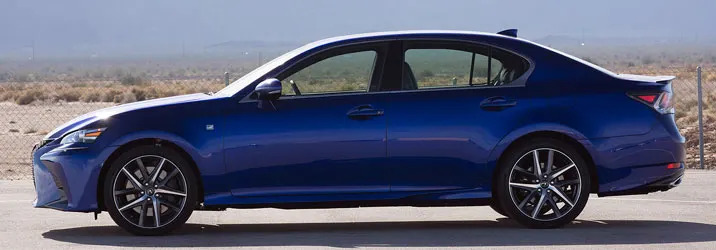

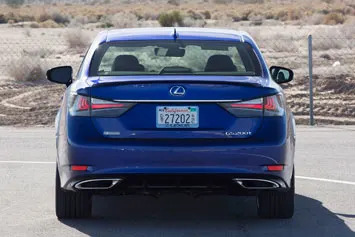
Fuel economy is another head-scratcher. Lexus estimates the GS 200t F Sport returns just 20 miles per gallon in the city and 30 mpg on the highway, three and four mpg less than the 5er. This brand-new 2.0-liter turbo is hardly more efficient than the three-year-old GS 350. The V6 model nets 19 mpg city and 28 mpg on the highway, and is 1.3 seconds quicker to 60 mph. A smaller engine almost always means sacrificing performance for economy, but based on the figures the 200t offers little reward for the slower acceleration.
At least the 200t is better from behind the wheel than on paper. We weren't that impressed by the low-end grunt of Lexus' 2.0-liter turbo when we drove it in the NX, but different gearing in the GS means snappier off-the-line behavior. Once the turbo catches up you're well into the heart of the torque curve, and the GS feels quicker than a seven-second jog to 60 mph. Mid-range punch is the engine's most endearing quality. Passing moves are easy and entertaining, even when you're already traveling at or above freeway speeds. Unfortunately, the engine gasps above 4,400 rpm.
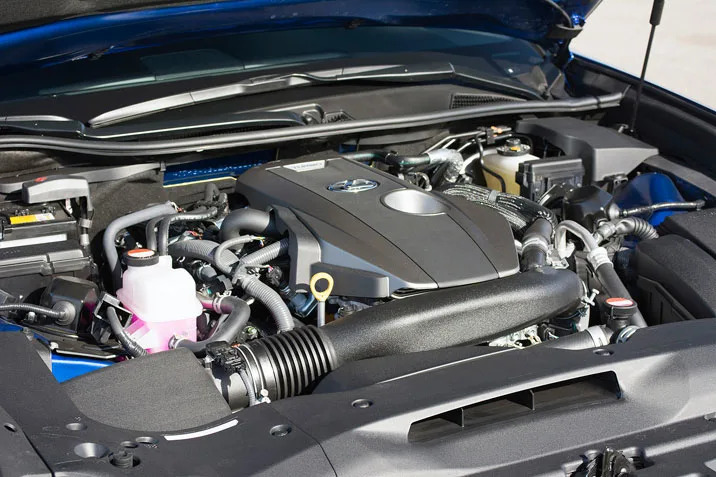
The best thing we can say about the 2.0-liter GS is that it sounds better than the V6. Lexus makes a mess of artificial sound induction with its six- and eight-cylinder engines. On cars like the GS 350, drivers live with a meek engine note at low rpms, only to be blasted with artificial noise at higher engine speeds. But engineers toned down piped-in noise on the GS 200t. You hear the typical Lexus-smooth engine song as you accelerate, but it's not overbearing. Lexus, do this across your range.
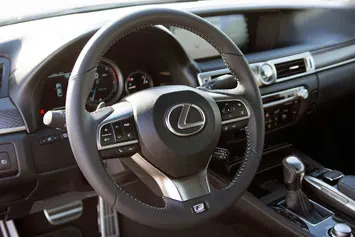
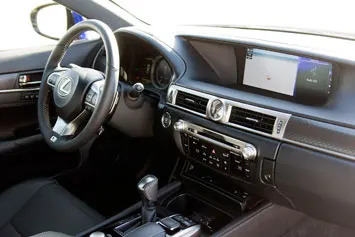
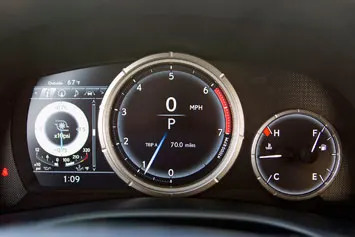
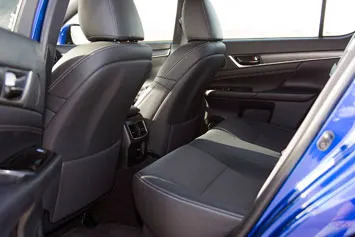
This is a $1,700 option on the GS 350 F Sport that adds a variable-ratio steering rack and rear-wheel steering. But you can't get this on the GS 200t. The standard steering's pleasant weight and sharp response are two of the best things about the GS, but just like when we tested it in 2013, the tiller is short on feedback. It's clear that this is a luxury sedan first, and a sport sedan second. And without the Dynamic Handling goodies, the GS 200t feels even less sporty. At least GS 200t F Sports get the same Adaptive Variable Suspension, adjustable shocks, and ultimately, a similar driving feel compared to the standard V6 F Sport. Turn-in is quick and roll is progressive, and there's an overbearing sense of lightness to the handling character.
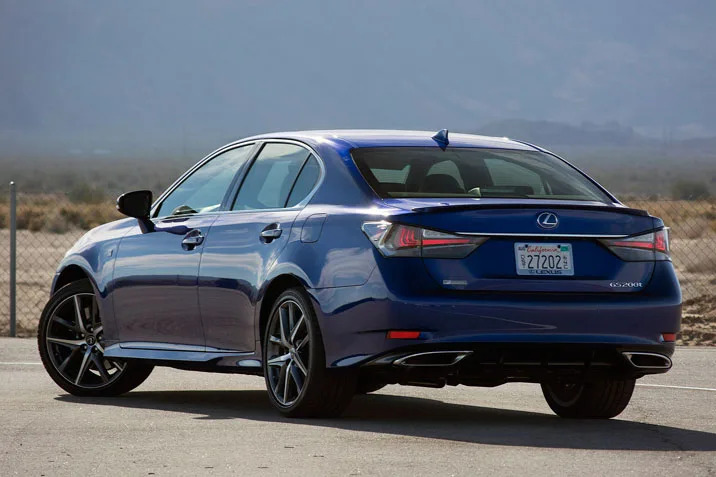
Despite the shortcomings, there's an inherently likable quality to the GS 200t and its turbocharged engine. The fat torque curve suits the car's casual performance character, and the reasonable price softens the envy to the faster, more efficient 5 Series. But pleasant as the GS 200t is, we're still looking for an overall payoff from the engine downsizing. Maybe Lexus hypnotized itself with that ad line about being satisfied with a four-cylinder.
Oh, how times have changed.
Consider the facelifted Lexus GS 200t and its four-cylinder turbocharged engine an admission that maybe the Germans are on to something. It's good to see Lexus getting with the times, but after a drive in Southern California, we find the first turbocharged GS comes up short in a lot of ways.
This is the same engine Lexus uses in the NX, IS, and RC with 200t designations. The 2.0-liter four-cylinder uses a twin-scroll turbo, direct injection, and Toyota's most advanced continuously variable valve timing to produce 241 horsepower and 258 pound-feet of torque. That's 70 horsepower short of the GS 350's 3.5-liter V6. But torque is down only 22 fewer lb-ft, and the 200t's broad peak torque, from 1,650 to 4,400 rpm, promises ample usable power.



As for that previously-mocked BMW 5 series, the Lexus has nearly identical output. But a 7.0-second 0-60 time is nearly a full second slower than the BMW's claim for the 528i, a car that weighs practically the same as the Lexus.The 200t offers little reward for the slower acceleration.
Fuel economy is another head-scratcher. Lexus estimates the GS 200t F Sport returns just 20 miles per gallon in the city and 30 mpg on the highway, three and four mpg less than the 5er. This brand-new 2.0-liter turbo is hardly more efficient than the three-year-old GS 350. The V6 model nets 19 mpg city and 28 mpg on the highway, and is 1.3 seconds quicker to 60 mph. A smaller engine almost always means sacrificing performance for economy, but based on the figures the 200t offers little reward for the slower acceleration.
At least the 200t is better from behind the wheel than on paper. We weren't that impressed by the low-end grunt of Lexus' 2.0-liter turbo when we drove it in the NX, but different gearing in the GS means snappier off-the-line behavior. Once the turbo catches up you're well into the heart of the torque curve, and the GS feels quicker than a seven-second jog to 60 mph. Mid-range punch is the engine's most endearing quality. Passing moves are easy and entertaining, even when you're already traveling at or above freeway speeds. Unfortunately, the engine gasps above 4,400 rpm.

Because it's only offered with rear-wheel drive, the GS 200t's potential to conquest sales from the Germans is limited in a market hungry for all-wheel drive. Unlike the six-speed auto in the GS 350 AWD, rear-drive models share the same Aisin eight-speed automatic. In the turbocharged GS this gearbox hunts too much on downshifts, especially at freeway speeds. Shift speeds improve considerably as you dial up the Drive Mode Select system and take advantage of the wheel-mounted paddles. Like the GS F, Sport S+ is the most pleasing, but even Sport S with the car in full auto provides some relief from the relaxed downshifts of Normal mode. The paddles themselves are sized well, but there's too much travel to feel totally satisfying.The best thing we can say about the 2.0-liter GS is that it sounds better than the V6.
The best thing we can say about the 2.0-liter GS is that it sounds better than the V6. Lexus makes a mess of artificial sound induction with its six- and eight-cylinder engines. On cars like the GS 350, drivers live with a meek engine note at low rpms, only to be blasted with artificial noise at higher engine speeds. But engineers toned down piped-in noise on the GS 200t. You hear the typical Lexus-smooth engine song as you accelerate, but it's not overbearing. Lexus, do this across your range.




Aside from the 200t badge on the trunk, our tester looks just like its six-cylinder brother inside and out. F Sport trim, popular enough to come on half of V6 GS sedans, is available here as well. But Lexus removed one of the most important features from the F Sport line: the Dynamic Handling System.But Lexus removed one of the most important features from the F Sport line: the Dynamic Handling System.
This is a $1,700 option on the GS 350 F Sport that adds a variable-ratio steering rack and rear-wheel steering. But you can't get this on the GS 200t. The standard steering's pleasant weight and sharp response are two of the best things about the GS, but just like when we tested it in 2013, the tiller is short on feedback. It's clear that this is a luxury sedan first, and a sport sedan second. And without the Dynamic Handling goodies, the GS 200t feels even less sporty. At least GS 200t F Sports get the same Adaptive Variable Suspension, adjustable shocks, and ultimately, a similar driving feel compared to the standard V6 F Sport. Turn-in is quick and roll is progressive, and there's an overbearing sense of lightness to the handling character.

If the GS 200t falls short in ultimate performance or handling, it stands strong on price. A BMW 5 Series built to the equivalent of our $58,565 GS would cost nearly $70,000. Simply put, the GS gives you more stuff for the money. Our tester adds striking Ultrasonic Blue Mica 2.0 paint ($595), navigation ($1,730), the $635 Safety System+ (forward collision warning, adaptive cruise control, lane keeping assist, and lane departure warning with steering assist), and a 15-speaker, 835-watt Mark Levinson surround stereo ($1,380) to the F Sport's $54,225 starting price. But again, the comparison to GS 350 looks bad. You'll save all of $830 by passing on the V6, and that's not enough to warrant the sacrifice in power.We're still looking for an overall payoff from the engine downsizing.
Despite the shortcomings, there's an inherently likable quality to the GS 200t and its turbocharged engine. The fat torque curve suits the car's casual performance character, and the reasonable price softens the envy to the faster, more efficient 5 Series. But pleasant as the GS 200t is, we're still looking for an overall payoff from the engine downsizing. Maybe Lexus hypnotized itself with that ad line about being satisfied with a four-cylinder.
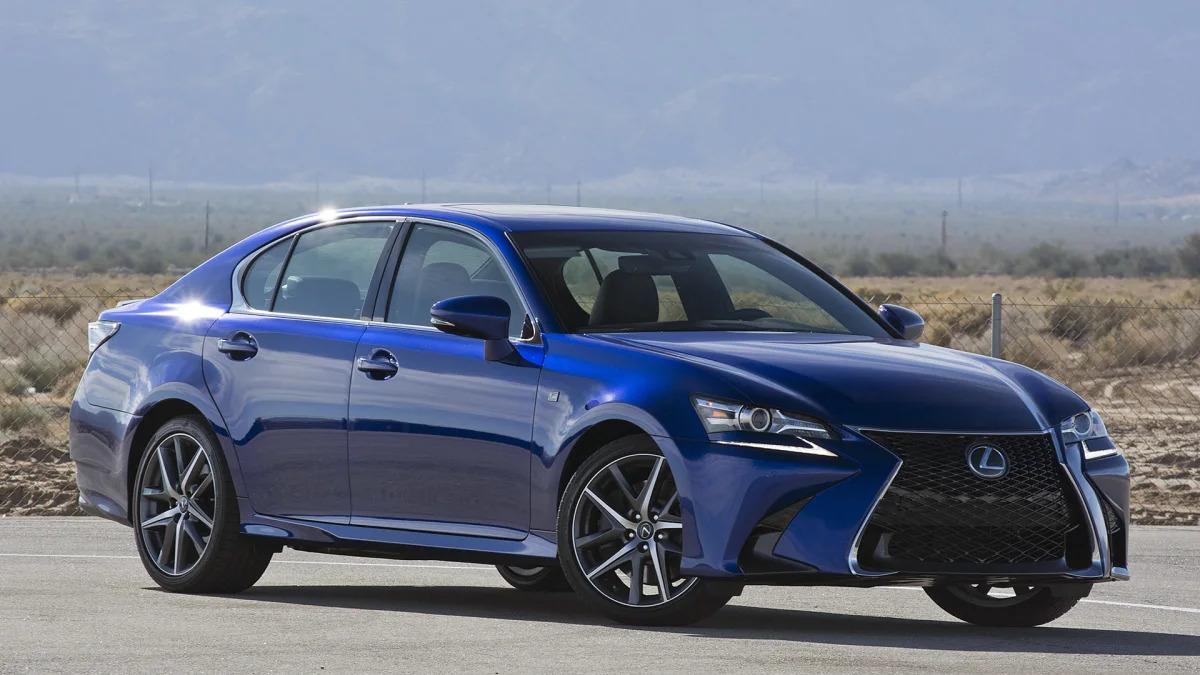









Sign in to post
Please sign in to leave a comment.
Continue